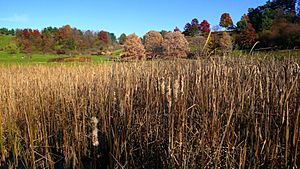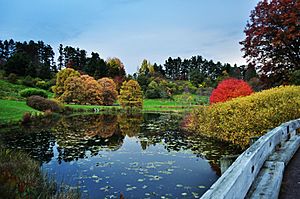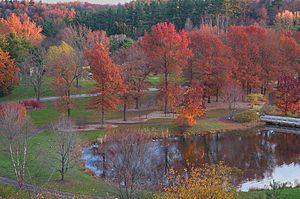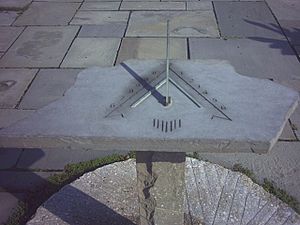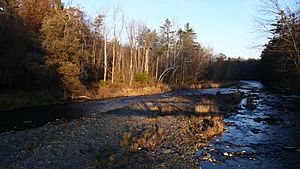Cornell Botanic Gardens facts for kids
Quick facts for kids Cornell Botanic Gardens |
|
|---|---|
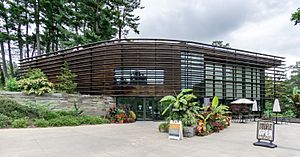
Nevin Welcome Center at the Botanic Gardens
|
|
| Nearest city | Ithaca, New York, United States |
| Area | 4,300 acres (1,700 ha) |
| Established | 1875 |
| Owned by | Cornell University |
| Budget | $2.9 million (2009) |
| Parking | On site |
| Website | Website |
The Cornell Botanic Gardens is a special place for plants and nature. It's located next to the Cornell University campus in Ithaca, New York. Imagine a huge outdoor classroom and a beautiful park all in one!
The main Botanic Gardens cover about 25 acres. This includes the F.R. Newman Arboretum, which is 150 acres. But the entire Botanic Gardens area is much bigger. It includes 40 different nature spots around Cornell and Ithaca, covering a massive 4,300 acres.
This amazing place started way back in the mid-1800s. It grew from Cornell University's interest in farming, forests, and nature. A big planting effort happened in the 1930s. The gardens were first called Cornell Plantations in 1944. Over the years, the gardens and buildings have kept growing. They even added new buildings in the early 2000s.
The Botanic Gardens also take care of four gardens right on Cornell's main campus. Students use the gardens for classes, and there are many talks and tours for everyone. In 2016, the name officially changed to Cornell Botanic Gardens.
These gardens are known for their collection of trees and bushes that grow naturally in New York State. The themed herb garden is also very famous. The Botanic Gardens are open every day for free. Many travel guides suggest visiting this wonderful natural space.
Contents
Exploring the History of Cornell Botanic Gardens
The story of Cornell Botanic Gardens began even before Cornell University was founded. In 1862, Andrew Dickson White, Cornell's first president, dreamed of a great university with a botanical garden. When the university opened in 1868, a famous naturalist named Louis Agassiz said that Cornell's surroundings were perfect for studying nature. Cornell quickly became known for its new ways of studying natural sciences. This included starting the first College of Agriculture.
In 1875, the university built its first women's dorm. It had a special greenhouse for plants and a collection of unique trees. The College of Veterinary Medicine also started a garden of plants that are harmful to farm animals. The university's land had two deep gorges with lots of native plants and wildlife. These gorges became the first parts of the on-campus gardens. People started suggesting the idea of a full arboretum (a place for trees) as early as 1877.
Cornell started getting forest land away from campus in 1898. This was when the first forestry college in North America began. In 1935, the university finally decided to create a proper arboretum. From 1935 to 1940, a government program called the Civilian Conservation Corps helped a lot. About 170 to 200 workers planted trees, built dikes, and made trails to develop the arboretum.
In 1944, a very respected plant expert named Liberty Hyde Bailey suggested the name "Cornell Plantations." By 1948, the Plantations covered 1,000 acres. A radio broadcast in 1949 talked about how important the connection between people and plants is. It said that gardens and parks are like lasting collections that future generations will care for.
In the mid-1960s, a sculpture garden was built in the middle of the arboretum. By 1965, the Plantations had grown to 1,500 acres. In the early 1970s, the arboretum got new roads and plantings thanks to gifts from Floyd R. Newman. In 1982, the arboretum was named the F.R. Newman Arboretum in his honor.
A New Name for the Gardens
In the 1980s, some people tried to steal trees from the Plantations, especially pines and firs for Christmas trees. To stop this, the staff sprayed the trees with a harmless but ugly "Ugly Mix." This spray made the trees look bad, so thieves wouldn't want them. Later, in 2009, some new or rare plants were stolen. The director said the thieves were likely experienced plant experts.
At the start of the 2000s, the Plantations began building many new facilities. This included a Horticultural Center and an Administration Building. The new Brian C. Nevin Welcome Center opened in 2010. It was designed to be very eco-friendly and won an award.
By the 2010s, the name "Cornell Plantations" started to cause problems. The word "plantation" reminded some people of large farms in the American South that used enslaved workers. Also, the word "plantation" usually means a big farm growing just one type of crop for money, which wasn't what these gardens were. For about ten years, people discussed changing the name. Finally, after surveys and polls, the name was changed in 2016 to Cornell Botanic Gardens. This new name better describes what the gardens are all about.
What You Can See Today
The Cornell Botanic Gardens are divided into different sections. Each section has its own special plants and features.
The F.R. Newman Arboretum: A Forest of Trees
The F.R. Newman Arboretum is a large area of 150 acres. It's like a living museum of trees and shrubs. Here are some of the tree collections you can find:
- Chestnut Collection: Started in 2000, this collection has different types of chestnut trees.
- Conifer Collection: This area has many kinds of firs, pines, and spruces.
- Crabapple Collection: You'll find 83 different types of crabapple trees here.
- Maple Collection: This is one of the main collections. It has many types of maple trees, including red, sugar, and silver maples. There are also smaller Asian maples.
- Oak Collection: This collection aims to have all oak species that can grow in this climate.
- Shrub Collection: Different types of shrubs are planted all over the arboretum.
- Walnut Collection: This is the oldest collection, started in the early 1960s. It has black walnut, butternut, and heartnut trees.
The arboretum also has many trails for walking and exploring.
Botanical Gardens: A World of Plants
The botanical gardens cover 25 acres. They focus on plants native to New York State. But they also have many other beautiful and useful plants. Here are some of the themed gardens:
- Container Gardens: These gardens show plants that grow well in pots.
- Deans Garden: This garden has both leafy and woody plants, some of which are rare in the Ithaca area.
- Decorative Arts Flower Garden: Full of colorful flowers like sunflowers, roses, poppies, and tulips.
- Flowering Shrub and Ornamental Grass Garden: This garden features beautiful flowering bushes and different types of ornamental grasses.
- Groundcover Garden: This area shows plants that spread low to cover the ground.
- Robison Herb Garden: Opened in 1974, this garden has 17 raised beds of herbs. They are arranged by themes like "Culinary Herbs," "Medicinal Herbs," and "Fragrant Herbs." It's a wonderful place to learn about how herbs are used.
- Heritage Vegetable Garden: This garden has four beds showing vegetables grown in different time periods, from the 18th century to today.
- International Crop and Weed Garden: Here you can see important crop plants from around the world, like bananas, sugarcane, coffee, and tea. It also shows weeds in an interesting way.
- Peony and Sun Perennial Garden: This garden has over 90 types of peonies and other plants that love the sun.
- Poisonous Plants Garden: This special garden displays plants that are harmful to farm animals.
- Rhododendron and Woodland Perennial Garden: Hundreds of rhododendrons and azaleas grow here among pines and ferns.
- Rock Garden: This garden features plants that thrive in rocky areas.
- Wildflower Garden: You can find beautiful native wildflowers here, like skunk cabbage and trillium.
- Winter Garden: This garden is designed to look interesting in all seasons, even winter. It has plants like dogwood, willow, and birch.
- Woodland Streamside Garden: A boardwalk takes you through a wet, boggy area with ferns and colorful irises.
Nature Areas: Wild Spaces to Explore
Beyond the gardens and arboretum, Cornell Botanic Gardens also looks after 3,500 acres of natural areas. These include bogs, fens, gorges, glens, meadows, and woodlands. These wild spaces have about 9 miles of walking trails. Some notable areas include:
- Bald Hill: Known for its mountain laurel plants.
- Beebe Lake and Woods: A beautiful lake created by a dam on Fall Creek.
- Cascadilla Gorge: A stunning gorge with a walking trail and many waterfalls.
- Fischer Old-Growth Forest: A rare forest with very old trees.
- McLean Bogs: A special natural landmark with two small kettle bogs.
- Slaterville 600: A large area of 600 acres that includes a wildflower preserve and old-growth forest.
Learning and Research at the Gardens
The Botanic Gardens play a big role in education at Cornell University. Many students use the gardens for their classes, especially in subjects like horticulture and earth sciences. The gardens offer courses for academic credit, and also host many informal talks and tours for the public.
The Botanic Gardens work closely with Cornell's other programs. Some of the university's buildings even have gardens maintained by the Botanic Gardens. While other university lands are mainly for teaching and research, the Botanic Gardens are open to everyone. They are designed for both learning and enjoying nature.
Public gardens like Cornell Botanic Gardens have become very popular. They help bring the campus together, attract new students, connect with the local community, and provide a place for ongoing research. They are like "living museums" where you can learn about plants firsthand.
The Botanic Gardens have been featured in many books and films. A 1973 survey by The New York Times called the Plantations one of the best places in the Eastern U.S. for education. The Robison Herb Garden was even called "a student's living reference library."
The gardens also work on important projects, like trying to bring back the American globeflower plant. They are also trying to control a pest called the hemlock wooly adelgid using special beetles.
Visiting the Gardens
The Cornell Botanic Gardens are open every day from morning until evening, and there's no charge to enter. You can easily walk there from the Cornell campus. Guided tours are offered twice a week. Many volunteers help out as tour guides and event staff.
Many travel guides and newspapers have recommended visiting the Cornell Botanic Gardens. The New York Times has called it a "satisfying experience" and a "real find." The Boston Globe described it as a "free to the public museum of living plants." The Ithaca Journal called it "one of the area's gems."
The gardens are also listed in guides like National Geographic's best public gardens and the American Automobile Association's TourBook. Travel books like Frommer's highly recommend a visit, especially praising the herb garden and the rhododendrons.
The Botanic Gardens host many annual events, like a "Fall In" festival and an Arbor Day celebration. They are also part of the Ithaca Discovery Trail network, which connects different cultural and educational sites. There's even a student group called "Friends of the Gorges" that helps keep the trails clean and well-maintained.
|
See also
 In Spanish: Plantaciones Cornell para niños
In Spanish: Plantaciones Cornell para niños


